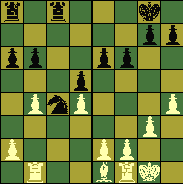
Lecture by UMBC Chess Coach Igor Epshteyn
The competition of minor pieces starts from the first move of opening, but real competition accelerates during the pawn structure formation. There are some notes that allow to recognize the superiority of the knight:
In the battle of knight against the bishop next points are vitally important:
The first game demonstrates the strategy of gradual restriction of enemy bishop, performed by world champion M.Botvinnik against multitime champion of the USSR and many times contender of International Candidate Tournaments Leonid Shtein. Botvinnik completely outplayed the opponent strategicly, but Shtein set against much elder classic of chess(at this time Botvinnik was 56!), extremely stubborn tactical play, that allowed him to provoke Botvinnik to make tactical mistake and loose the game.
This game, despite of the result , has everlasting instructiveness and strategical value.
The second game from Interzonal of 1953(Zurich), also is brightened by very logical and gradual transition to the favorable endgame. The third game Botvinnik - Rjumin contains both elements of strategical battle in middlegame and converting an edge in endgame as virtual opportunity for White.
1. e4 e5
2. Nf3 Nc6
3. Bb5 a6
4. Ba4 Nf6
5. Bxc6 dxc6
6. d3 Nd7
7. Nbd2 Be7
8. Nc4 Bf6
9. 0-0 0-0
10. b4 Qe7
11. a4 Re8
12. Ba3 b5
13. Na5 Qd6
14. c4 Nf8
15. c5 Qe6
16. Re1 Rd8
17. Qc2 Ng6
18. Bc1 Nh4
19. Nxh4 Bxh4
20. Bb2 Re8
21. Re2 Qg6
22. f3 Re6
23. Bc3 Qh5
24. Qb2 Bg5
25. Rf1 Bf4
26. g4 Qh3
27. Bd2 Rg6
28. Bxf4 exf4
29. Rg2 h5
30. Qe5 hxg4
31. Qxf4 bxa4
32. Rg3 gxf3
33. Rxg6 fxg6
34. Rxf3 Qg4
35. Qxg4 Bxg4
36. Rg3 Bd7
37. Rg2 Rf8
38. Nc4 Bh3
39. Rf2 Rd8
40. Rf3 Be6
41. Na3 Bb3
42. Kf2 Rb8
43. Rg3 Bf7
44. Ke3 Rxb4
45. Rg1 Rb2
46. Rb1 Ra2
47. Rb8 Kh7
48. Nc4 Bxc4
49. dxc4 a3
0-1
1. c4 Nf6
2. Nf3 e6
3. g3 b6
4. Bg2 Bb7
5. 0-0 Be7
6. d4 0-0
7. Nc3 Ne4
8. Qc2 Nxc3
9. bxc3 Nc6
10. Ne5 Na5
11. Bxb7 Nxb7
12. Qa4 d6
13. Nd3 Na5
14. c5 Qe8
15. Qxe8 Rfxe8
16. Rb1 Rec8
17. h4 d5
18. Bf4 f6
19. Nb4 a6
20. cxb6 cxb6
21. Bd2 Nc4
22. Be1 Bxb4
23. cxb4 Na3
24. Rb3 Nb5
25. e3 Rc2
26. a4 Nd6
27. a5 b5
28. Rc3 Rc8
29. Rxc8 Nxc8
30. f3 Ne7
31. Bf2 Kf7
32. Rb1 Nf5
33. Kf1 Nd6
34. Rb3 Nc4
35. Kg2 f5
36. Rb1 Nxe3
37. Kg1 f4
38. gxf4 Nf5
39. Kf1 g6
40. Rb3 Ke7
41. Rb1 Kd7
0-1
Questions:
1. Nf3 f5
2. g3 Nf6
3. Bg2 e6
4. 0-0 Be7
5. c4 0-0
6. b3 Qe8
7. Nc3 Qh5
8. Qc2 Nc6
9. d4 d6
10. Ba3 Rf7
11. Rad1 Bd7
12. d5 Nd8
13. dxe6 Nxe6
14. c5 dxc5
15. Ne5 Nd4
16. Qd3 Ng4
17. Nxg4 fxg4
18. Bxb7 Raf8
19. Bd5 Be6
20. Bxe6 Nxe6
21. Ne4 Nd4
22. Bb2 Rd8
23. Qc4 Qe5
24. Bxd4 cxd4
25. f3 gxf3
26. Rxf3 Qd5
27. Rxf7 Kxf7
28. Rxd4 Qxc4
29. Rxc4 c5
30. Kf2 Rd5
31. Ra4 Rd4
32. Nc3 Rxa4
33. Nxa4 Ke6
34. Ke3 Kf5
35. Kf3 Ke5
36. e3 Bd6
37. Nb2 Kd5
38. Nc4 Bc7
39. Ke2 Ke4
40. Nd2 Kf5
41. Kf3 Ke5
42. Nc4 Kd5
43. Ke2 Ke4
44. Nd2 Kf5
45. Kf3 Ke5
46. g4 Kd5
47. h3 Bd8
48. Ke2 Bc7
49. Kd3 Bg3
50. Ne4 Be1
51. Ng5 h6
52. Ne4 Bh4
53. Nc3 Kc6
54. Ke4 Bf6
55. Nb1 Kd6
56. Na3 Ke6
57. Nb5 a5
58. Nc7 Kd7
59. Nd5 Bb2
60. Nb6
1-0

Questions (White to move):